Kingston A1000 M.2 SSD Review
The Kingston A1000 M.2 NVMe - Fast & Reliable performance on a budget!
Kingston is a name well known when it comes to high performance memory kits and storage drives especially through their HyperX lineup which offers their top of the line hardware that holds its own grounds against what other brands have to offer. Some time back they came up with their first ever NVMe SSD in form of the KC1000 which is a premium PCIe based SSD in the ever popular M.2 form factor. With that all done and dusted Kingston now decided to tap on the newly emerged and fast growing budget NVMe drive market with their latest Kingston A1000 NVMe M.2 SSD which happens to be their second NVMe SSD ever and with that A in the nomenclature signifies the budget nature of the product.
With a price tag of $70 the Kingston A1000 iks powered by a Phison PS5008-E8 controller and happens to be competitively priced boasting a read and write speed of 1500MB/s and 800MB/s respectively which is what we expect from a drive of this nature. Its directly aiming to replace a conventional SATA SSD in your PC for a boot drive or for loading vital softwares and to be a nifty replacement/addition to slim laptops and ultra-books just to keep things clear here. Coming in at 240GB, 480GB and 960GB only the drive doesn't offer a a 120GB which I don't think anyone needs but a full 1TB version would've been a welcome move since the 960GB won't offer full capacity like any other storage drive on the market.
The Kingston A1000 also comes with a 5-year limited warranty and our model is rated for 150TBW while all of them compliant with the newest NVMe 1.3 protocol.
Packing and Closer Look
A simple clam-shell pack that's it! Kingston has packed the A1000 in the most basic packing possible housing the drive inside a clear clam-shell with a sticker cum seal that goes all the way around the pack and has all the serial and model numbers at the bottom end.
Not too big of a fan of fancy packing but this seems like a prototype packing rather than the final product, which i hope it is and Kingston atleast puts it in a cardboard box with all the logos, names etc.
Inside you get the drive seated in its own exclusive casing for added protection along with a multilingual warranty card and activation key for the Kingston cloning utility, Acronis. Its a nice addition for a semi-premium product and would save most users a ton of time by offering a free cloning utility since the product is aimed as a direct replacement for boot/primary drives.
The A1000 is a single sided drive with the controller, cache and memory chips all on the same side leaving the back side vacant. It adheres to the 2280 (80mm) form factor standards and the sticker on top is one of the hardest to pull off from all the drives that I've reviewed so far which obviously if peeled off will void you warranty.
Kingston opted for the quad-channel Phison PS5008-E8 SSD controller which utilizes PCIe3.0x2 planes over the conventional PCIe3.0x4 lanes that most NVMe drives utilize, this is interesting as Kingston is betting on improved performance by architectural refinements of the controller over more PCIe lanes to cut down the cost and make the drive more cost effective.
We also see four 64-layer 3D TLC NAND flash memory from Toshiba which is their latest product and promises fast and reliable performance. As for the buffer we have a 1GB DDR3 cache by Nanya working at 1600Mhz.
Test Setup and Benchmarks
We used our usual testbench to benchmark the Kingston A1000 240GB NVMe M.2 SSD -
CPU: AMD Ryzen 7 1700 @3.6Ghz
Motherboard: Asus X370 Crosshair VI Hero
RAM: GALAX HOF 32GB 3600Mhz
Cooler: Corsair H150i Pro RGB
Graphics Card: MSI RX 580 Gaming X 8G
Storage: Kingston A400 256GB
Secondary Storage: Kingston A1000 240GB NVMe M.2
Power Supply: Corsair AX860i 860W
Case: Corsair Obsidian 750D
OS: Windows 10 Pro 64-bit
The drive was easy to fit in and installed without a problem. Following
our usual SSD testing methods we formatted the drive and put it as a
secondary drive with our main SSD loaded with Windows 10 Pro 64-bit.
The entire test suite was run twice to obtain the best possible reading,
each session performed after a fresh system restart. Out of the 240GB
promised only 224GB on this drive is usable so around 7% of the total
space is reserved for memory buffer.
TRIM Check
Since this is a very new SSD for us so it called for some new testing
suits aswell, one such tool is TrimCheck which verifies if TRIM function
on the drive is working perfectly or not.
The test shows that TRIM is working perfectly on the SSD.
Crystal Disk Info V7.0.5
Crystal Disk Info is a great tool for displaying the characteristics and
health of storage devices. It displays everything from temperatures, to
the number of hours the device has been powered, and even to the extent
of informing you of the firmware of the device.
Crystal Disk Info shows us that a bunch of useful SMART attributes are
presented to the end user. Total reads and writes as well as NAND writes
are shown. The firmware version we are testing with today is version E8FK11.G with the drive working at optimum temperatures even during
summers.
ATTO Disk
ATTO Disk Benchmark measures transfer rates across specific lengths for
any storage system. ATTO uses RAW data, I set my transfer size from 0.5
to 8192kb. This is generally the most reliable benchmarks for today's
SSDs.
We can clearly see that the speed put up by the A1000 are almost double to what a conventional SATA SSD does and is a perfect match to the advertised speeds on the spec sheet.
CrystalDiskMark 5.0.2
CrystalDiskMark is a disk benchmark software that analyses different
types of hard drive. Giving sequential benchmark write and read
statistics in MB/s. A simple program that is very useful.
A similar scenario is what we are seeing here aswell and even though the Kingston A1000 uses only two PCIe3.0 lanes instead of four the results are impressive so far.
Anvil Storage Utility
The next test is Anvil Storage Utilities, which is a really great piece
of software. The SSD benchmark gives you scores for both read and write
as well as a combined score.
Identical results yet again in terms of performance aswell as on the IOPS end which is same as that on the specification sheets.
AS SSD
The AS SSD software determines the performance of Solid State Drives
(SSD). The tool contains five synthetic and three practice tests. The
synthetic tests determine the sequential and random read and write
performance of the SSD. These tests are performed without using the
operating system caches. In Sequential tests, the program measures the
time it takes to read and write a 1 GB file respectively.
With an impressive score of above 2000 points the A1000 blazes ahead of the competition in every suit here including the Copy benchmark which emulates real life performance compromising of miscellaneous data types and sizes.
AIDA64 Extreme Edition v5.60
AIDA64 is one of the best tools out there to check the system stability, error diagnostics and even to validate overclocking.
It has a set of suites for almost every hardware out there including SSD/HDD. So we started of with AIDA64 disk suites.
As we can see that the drive is hitting the advertised speeds and is
extremely consistent in read and write activities. This is a very good
indications since most drives including the XPG SX8000 tend to fluctuate a
lot in the Linear and Random Read tests indicating towards a more solid
and consistent performance by the A1000.
HD Tune Pro
HD Tune Pro is one of the most popular hard drive software suites
available. It has many different benchmarks and tests built into it. Our
first test is the read benchmark, which tests the average read speed
and access time of the drive.
It was necessary to use it even after so many tests just to give all of
you a graph of how constant the speed is on this SSD as many SSDs tend
to fluctuate on the read/write speed which ultimately gives you unstable
performance.
A brilliant performance presented by the A1000 yet again where its
beating the competition by substantial margin! The drive is not only
extremely consistent but shows really high speeds.
PCMark 8 Professional Edition
PCMark 8 Storage Test unlike PCMark Vantage scores and records the SSD
performance through a set of application execution and related tasks
such as Adobe Photoshop, Microsoft Office and even through games like
Battlefield 3.
The scores are quite respectable and significantly more than the SATA drives both in terms of overall score and storage bandwidth.
My Verdict
My experience over the years tell me that Kingston doesn't disappoint when it comes to storage drives most of the times especially when we consider the likes of high end Savage to the entry level A400. The A1000 M.2 NVMe is an interesting drive to be honest, it is meant to be an entry level solution of NVMe drives that aim to replace the conventional SATA drives on PCs and laptops alike for people who don't want the highest speeds possible and feel that their current work load is bottle-necked by their SATA SSDs, on the other hand it utilizes a PCIe3.0x2 interface over the PCIe3.0x4 that NVMe drives do and we can see the performance hit in cases like that of the PCMark 8 score where the limited bandwidth chokes the A1000 under extensive loads.
The drive does run cool with a 38° at idle and 58° under full load for a long period of time even when I tested it inside a closes chassis with high ambient temperature so that's a very good thing as there was no thermal throttling whatsoever. Its priced quite well atleast in the US as I don't have the final pricing for India pitting it extremely close to SATA SSDs in terms of price per GB and at times its cheaper to some of the high end premium SATA drives that offer lower overall performance than this giving the Kingston A1000 a huge benefit.
"With a solid performance, low thermals and an aggressive price to performance ratio the Kingston A1000 is a highly recommended rive to those who want to upgrade from a SATA SSD and utilize the near double speed the drive has to offer at a marginally higher price!"
Pros -
- Solid and Stable performance
- Runs cool
- Aggressively priced
Cons -
- Only PCIe3.0x2 interface
I give it a 7/10 earning our Silver Award
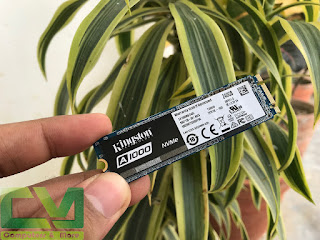










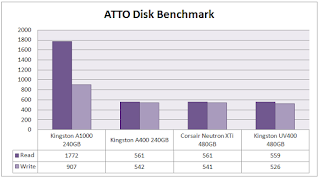



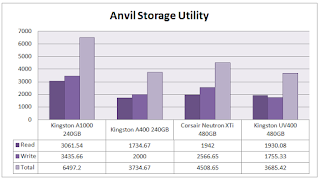
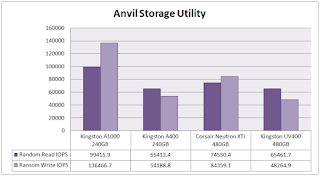











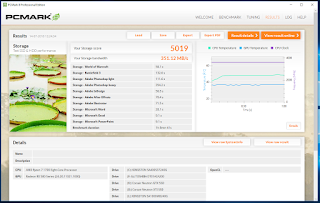


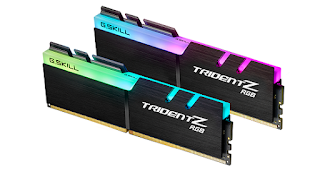

Comments
Post a Comment